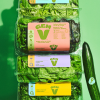
The famous food packaging! Many of us have a love-hate relationship with them. We see them everywhere, regardless of the industry. But what about the food industry? Are they really necessary? Are there options that are better than others?
We have asked ourselves these questions, because we are aware that packaging is part of our daily reality. However, at Cultures Gen V, we have the humility to say that even if we are not perfect, we don't look away from certain environmental issues either. The future of the planet concerns all of us. That's why we want to do our homework in order to progress towards greener business practices.
That's why our team has surrounded itself with eco-design experts, such as Annie Legroulx, a packaging eco-design consultant, the Institut de technologie des emballages et du génie alimentaires (ITEGA) and Éco Entreprise Québec (ÉEQ), in order to think about the most eco-friendly packaging options and thus improve our methods. We also visited one of Tricentris' sorting centers and did some research on the subject.
We learned so many interesting things that we decided to share it all with you!
Better understand the role of packaging
In the food industry, packaging has a usefulness that is not negligible. First of all, it is important to know that a good packaging serves as a protection for the food. In other words, it maintains its humidity level to improve its shelf life and keep it safe. The packaging also provides you with a lot of relevant information such as where the product comes from, its nutritional information and its ingredients.
In addition, by prolonging the freshness and shelf life of packaged foods, we help reduce food waste, which is an important environmental issue in Canada.
According to this study, 11.2 million metric tons of food loss and waste is generated in Canada each year. Eliminating food packaging altogether would lead to an increase in food waste and GHG emissions, and we don't want that!
So, do we opt for recyclable or biodegradable plastic packaging?
Now that you have a better idea of the role of packaging in our industry, you are probably wondering if there are some options that are better than others. Is it better to have plastic or compostable packaging?
Our main goal is to find packaging that helps preserve the quality of our food while having the least negative impact on the environment.
First, we notice that there are more and more innovations on the market to try to replace plastic packaging. We quickly think of "bioplastics" which can be made from plant materials or biodegradable.
However, thanks to this article, we understand that to be biodegradable, the material must be assimilated by microorganisms. Thus, a biosourced plastic, which is made from plants, is not necessarily biodegradable or even compostable. We were surprised to read that more than half of the biosourced plastics available on the market are not biodegradable at the moment. In fact, at the molecular level, some products are composed exactly the same way as petroleum-based plastics.
The other aspect to take into account in this reflection is related to our waste management system in Quebec which does not yet have all the equipment in each centers to treat this type of material. See what Éco Entreprise Québec has to say on the subject.
Indeed, one of the so-called compostable plastics that are gaining more and more popularity is polylactic acid (PLA). In order to make it compostable, we would need specific industrial composters. The issue is that this product is often found in compostable bins, but it is actually a contaminant. The result is that it ends up in landfills because we don't have the proper facilities to treat it properly.
In addition, these bioplastics cost 3 to 10 times more than regular plastics. This is an aspect that we also take into account since the more expensive the raw material is, the more we will have to increase the price of our products in grocery stores to remain profitable.
Possible soll
Possible solutions
Fortunately, there are solutions to reduce the environmental footprint of plastic.
First of all, the recyclable plastic option is the one that seems best to us so far, since it is part of a circular economy principle. Since our lettuce containers are fairly clean, they can be reused several times to recreate other types of plastic packaging.
We can also increase the percentage of recycled material in the manufacturing of the packaging to avoid using only virgin materials.
Another solution is to reduce the weight of the packaging. The lighter a package is, the less plastic it uses in its design.
Long live eco-designed packaging
Our lettuce containers are made of PET #1 plastic. This type of plastic is recyclable. For our mini cucumbers, the tray is made from recycled and recyclable fibers and is covered with a recyclable protective film. Finally, our lettuce bags for restaurants are made from recyclable LDPE #4 plastic.


